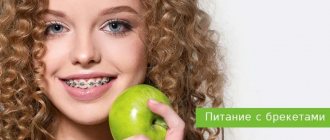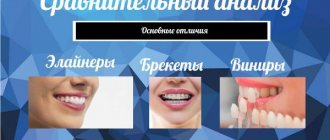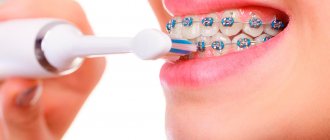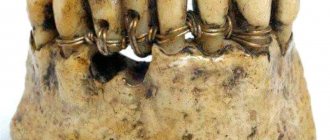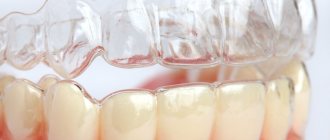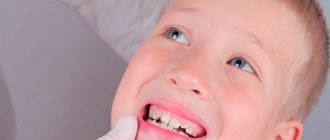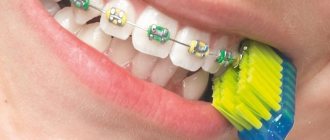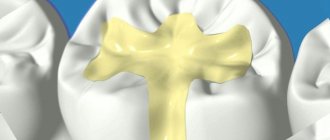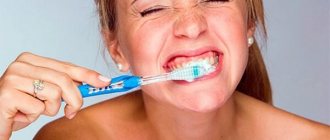Publication date: December 26, 2022.
Date the information on this page was updated: December 07, 2021.
Before installing braces, it is difficult to imagine the sensations in your mouth after installing an unusual structure made of ceramic or metal. Some people even put off orthodontic treatment due to fear of pain. In this article we will try to explain what sensations arise when installing, wearing and removing braces, why they occur and how to reduce discomfort.
Why does pain occur when wearing braces?
To begin with, let's figure out how the dental system works and how braces work. Teeth grow from the alveolar process, a bone formation in the jaw. The roots of the teeth are fixed in the bone tissue by a ligamentous apparatus - periodontium.
Due to the traction of the arc, braces move not only the part of the teeth that is visible to us - the crown, but also the roots of the teeth. Under the influence of braces, the ligaments, which contain many nerve endings, gradually stretch and the tooth moves along the bone tissue.
It is the processes of movement of the roots of teeth that cause sensations of varying degrees of intensity in people, depending on the individual pain threshold. Some people feel quite severe pain, some only have unpleasant feelings when biting food, others experience itching and mobility of teeth.
What does it feel like while wearing braces?
- Aching pain, especially aggravated when biting food and chewing.
- Chafing of cheeks, lips and tongue from clasps, orthodontic hooks and wires. During the first time after installation, the mucous membrane gets used to the structure in the mouth, the tongue and lips tend to take their usual position, but encounter braces. Sometimes it is impossible to close your lips or articulate clearly. Over time, the mouth and lips adapt to braces and the pain goes away. Getting used to with lingual braces takes longer than with classic braces, since they are located on the inside of the teeth and greatly interfere with the tongue.
- Feeling of tooth mobility and “soft” teeth. It seems that the tooth is loose or, when biting and pressing, “sinks” into the gum. In fact, the teeth are mobile, but not so much that they fall out or suddenly change position.
- Itching in the teeth and gums. Some patients' teeth do not hurt, but itch and itch. This, like aching pain, is the result of irritation of nerve endings during the gradual restructuring of periodontal and bone tissue. If you experience such sensations, you should never try to mechanically scratch your gums (with a toothpick, hard brush, etc.) - you can seriously injure yourself.
What can you eat in the first days after getting braces?
Almost immediately after fixing the brace system in the oral cavity, the patient will experience unpleasant sensations associated with increased pressure on the dentition. Chewing may cause severe pain. Therefore, experts recommend in the first days to give preference to soft and strained food. The following products and dishes are optimal:
- liquid porridge;
- soups;
- cottage cheese;
- kefir;
- yoghurts;
- jelly;
- vegetable puree, etc.
Five factors that influence how long you wear braces
The total time that patients wear braces is 1-3 years. How many months or years it will take in your case can only be predicted by an orthodontist (after examination and medical history). In advance, you can independently calculate the approximate time for which the structures are worn, taking into account five main factors:
- Patient's age.
- Type and complexity of violations.
- Type of bracket system.
- Qualification of an orthodontist.
- Care and implementation of recommendations.
Each of the factors has its own characteristics, which are worth considering in more detail.
Patient age
The specific time of use after installing braces is determined based on the clinical picture and individual characteristics of the jaw structure. But, you can rely on average data that is natural for different ages of patients:
- Children
. Due to the pliability of the dentofacial apparatus, which occurs at the age of 12-16 years, all processes to correct the bite occur quite quickly. Most often, 0.5-1 year is enough to correct moderate severity. - Teenagers
. During the period of active formation of the dental system, you can count not only on the effectiveness of the result, but also on the minimum time to achieve it. On average, adolescents aged 18-23 years need 3-8 months less to achieve the desired result than older patients. - Adults
. Since in an adult the dentofacial apparatus is already fully formed, regenerative processes in tissues are slowed down and the rate of metabolic processes decreases, orthodontic treatment will take 2-3 years.
The question of how long braces should be worn may also arise in older people - the use of these orthodontic structures can be shown as one of the preparatory stages before prosthetics. In this case, you will have to wear braces for several years.
Type and complexity of violations
Braces can solve a number of problems with bite and uneven teeth. Depending on the reasons why you are installing orthodontic structures and the severity of the defect, the time for using braces may vary:
- Alignment of one or more teeth
. If it is necessary to shift (change the position) of units in a row, you will have to wear braces for an average of 1.5 years. - Elimination of distal bite
. This pathology can be diagnosed with different stages of complexity. Depending on the severity of the defect, wearing orthodontic structures lasts 1-3 years. - Elimination of diastema
. If the gap between the incisors is not a cosmetic defect and does not require masking (for example, with veneers), but treatment, then the doctor will prescribe braces. How long it takes depends on the age of the patient. The average period is 1-2.5 years. - Correction of deep bite
. One of the most difficult cases that braces can solve. In childhood this will take about 1.5 years, and for adults – up to 3 years.
In the case of crowded teeth, dystopia and other dental defects that require the use of braces to resolve, the time frame is determined individually and varies between 1.5-3 years.
Type of bracket system
The chosen type of braces also influences how long to wear orthodontic systems:
- By material
:
Metal
. The strongest modern system that applies optimal pressure to tissue. It is used to correct even complex defects within a period of 1-1.5 years. - Plastic
. They are fragile and require the utmost care. You will have to wear these braces for 12-18 months. - Ceramic
. Durable and do not cause allergies. Used to correct simple defects. Requires extended wear time - up to 3 years. - Sapphire
. They require particularly careful oral care. The impact of such systems lasts 1.5-3 years.
:
- Lingual
. They are attached to the inner surface of the teeth. Used for 1.5-2.5 years.
. They are attached to the outer surface of the teeth. Used for 1-2 years.
:
- Ligatures
. The design allows you to work more accurately and with greater force on difficult areas. Accordingly, the wearing time is as short as possible - up to 1.5 years.
. They are worn longer than ligature ones - up to 2.5 years. This option is chosen by those who, while wearing braces, care about the aesthetics of their smile, and who are willing to sacrifice extra time wearing the system for the sake of beauty.
Most often, patients are shown several options for braces, from which they can choose the one that suits its appearance and price. Not the last factor will be how long you will have to wear braces and whether you are willing to deliberately increase the wearing time for the sake of aesthetics or want to correct the defect in the shortest possible time.
Qualification of an orthodontist
The time that you will have to wear the brace system and obtaining the desired result directly depend on the experience and qualifications of the specialized doctor:
- At the consultation stage
. It is important to get the right advice on choosing a brace system based on your clinical case. Not only indications, but also contraindications should be taken into account. - At the preparation stage
. A lot depends on the quality of taking impressions and setting the task for the laboratory specialist. Only an experienced orthodontist will be able to do all the preparatory steps correctly. - At the installation stage
. The braces themselves are attached strictly to certain places and at a certain angle - depending on the position and inclination of the teeth. The doctor’s lack of relevant experience will increase the time of wearing the orthodontic structure and will not give the desired effect of treatment at all.
By choosing the right clinic and specialist, you increase your chances of getting a perfect smile and a healthy bite as quickly as possible.
Care and implementation of recommendations
Keep in mind that how long you need to wear braces depends on your responsibility. For example, a late visit to change wires may stop or slow down treatment. And an irresponsible attitude towards oral hygiene can lead to the development of caries and other diseases, which will require immediate solutions to problems. And, since braces can interfere, they will have to be removed, reducing to zero all the results achieved so far. The chipping of one of the braces can also increase the wear time - while the analogue is being made, the result will slow down or stop altogether.
Not only failure to follow the recommendations of an orthopedic dentist, but also force majeure situations can lead to early removal of orthopedic structures. For example, the occurrence of allergic reactions to the design (most often to metal models) or the need for a surgical solution to correct the anomaly.
If you take the orthopedist’s recommendations responsibly and visit the clinic in a timely manner for the necessary manipulations with the arches, then you will be able to wear braces for the shortest possible time.
You might be interested in:
Installation of braces
Bite correction
Self-ligating braces
Damon Clear bracket system
Damon Q braces
Ligature braces
Clear braces
Removing braces from teeth
What food is preferred throughout treatment?
When the patient gets used to the brace system, you can gradually expand the diet. The following is a list of products that will not cause any harm to the orthodontic structure:
- soups;
- yoghurts, kefir;
- soft cheeses;
- soft chicken fillet, thin sliced meat;
- fish, crab sticks;
- eggs;
- pasta;
- boiled rice;
- mashed potatoes;
- soft pastries, pancakes, bread crumbs;
- applesauce;
- bananas;
- jelly;
- milkshakes;
- vegetable caviar, stewed vegetables;
- cutlets, pureed meat.
The list of recommended products is quite large. It is important to understand that you should not bite hard food with your teeth. But if, for example, you grate an apple or carrot, you can eat them without fear for the safety of your braces.
Good to know. Braces are the best “nutritionist”. By adhering to some dietary restrictions, patients will receive not only straight and beautiful teeth, but also a slender figure.
Alternative techniques
In cases where the problem of tooth sensitivity is pronounced, alternative methods for correcting malocclusion can be used. The use of removable aligners allows not only to avoid these symptoms, but also to eliminate such a serious drawback of treatment with braces as a violation of aesthetics. Aligners are effective, comfortable, and invisible to others. In addition, their use allows you to perform hygiene procedures in full.
However, no matter what method of bite correction the patient uses, to obtain the desired effect, the professional qualities of the orthodontist are the priority. Specialist Irina Aleksandrovna Butorina has the highest qualifications and extensive practical experience, which allows her to find the most optimal solution in each case and obtain the desired result even with increased tooth sensitivity.
Can braces come off?
The system is securely, but not tightly, attached to a special glue, and when biting on some products, its elements may come off. This most often occurs when eating solid foods. If one or more braces come off, you need to consult a doctor.
You can install braces at the Saint-Dent Clinic in Moscow. Qualified dentists of all specializations work here. The clinic uses advanced technologies and modern materials to treat patients. The contact page is located here Contacts. Patients can find out the cost of dental services here Prices for dental services.
What not to do with braces
When wearing braces on your teeth, you will have to get rid of some bad habits, which include:
- chewing the tip of a pen or pencil;
- nail biting;
- drinking alcohol, etc.
When installing a system, many people wonder why they should not drink alcohol. The reason for this is their high content of sugars and other substances that have a bad effect on the enamel, forming a hard coating on it. When they settle on its surface, they cause caries and discoloration of the enamel. In addition, particles deposited on the structure can lead to gradual deformation and a change in its shade.
Alcoholic drinks are also dangerous because they dry out the oral cavity, making it vulnerable to various negative factors. Thus, structural elements can injure the gums, enamel and oral mucosa.
Hard and sticky food
Eating solid foods leads to damage to the arch structure and displacement of the dentition. This also often causes locks to come unstuck. The following products are completely prohibited:
- nuts;
- crackers;
- seeds;
- hard treats (lollipops, caramels);
- hard fruits and vegetables.
Sticky and viscous products heavily contaminate the teeth and components of the orthodontic apparatus and are quite difficult to remove. They also cause the development of caries and inflammatory processes in the gums. You should refuse:
- soft sticky candies;
- chips;
- buns
- corn sticks and flakes;
- cheese;
- chewing gum.
Other restrictions when correcting bites
The list of prohibited products can be supplemented with the following items:
- Chocolate with nuts. This dessert is prohibited for several reasons. Nuts can injure tooth enamel or lead to breakage and unsticking of braces, and chocolate tends to stick to teeth and parts of the system, after which it is quite difficult to remove it from there.
- Any carbonated drinks. Due to increased acidity, they negatively affect the condition of the enamel (they can stain or discolor it). This leads to stains being found on the teeth after the braces are removed.
- Small-grained berries (raspberries, strawberries, etc.). Their small bones get stuck in the structural elements, which can damage it and ruin its appearance. Removing them from there is also difficult.
- Popcorn, because it may contain hard corn kernels.
Is it possible to eat chocolate while wearing braces?
It is advisable to completely exclude any chocolate from the diet, because it negatively affects the braces system. Dark chocolate may stain the structure. In addition, it is a hard product and, when bitten, can cause a number of negative consequences. As it melts in the oral cavity, it becomes viscous and sticks to tooth enamel and structural elements. The nuts and dried fruits it contains can cause the braces to break and come off.
Sticky food
It is strictly prohibited to eat sticky or viscous food while wearing the system. The reason for this is the adhesion of such substances to the brackets, arches and ligature. It will be quite difficult to remove it from there, and the remaining particles can trigger the process of oxidation and corrosion, which will lead to caries, inflammation in the gums and breakage of braces.
To avoid such disastrous consequences, you should exclude from your diet:
- corn flakes and sticks;
- cheese, especially processed cheese;
- soft bakery products;
- nougat;
- caramel;
- marshmallow;
- marmalade;
- toffee;
- chips;
- dried fruits.
Such products stick to the power arc, changing its position. Among other things, they can damage locks and ligatures. In this case, you will have to change the system to a new one.
In addition, these products can harm tooth enamel. They accumulate under the braces in hard-to-reach places. This leads to further proliferation of pathogenic microflora in the oral cavity. As a result, plaque forms on the teeth, caries appears, gums become inflamed, and tooth enamel is destroyed.
Thus, to eliminate the negative consequences, it will be necessary to suspend treatment, which will reduce its effectiveness.
If sticky food does get on the structure, you need to urgently clean all places where it accumulates using:
- toothbrush;
- special brush;
- floss;
- irrigator.
Chewing gum is specifically prohibited. If the bracket system gets stuck, it will have to be removed in the clinic using special devices and chemicals. You won't be able to do this on your own.
Hot and cold food
Even people with absolutely healthy teeth should not expose their teeth to sudden temperature changes. And if a person wears braces, eating too hot and cold food is completely prohibited. This is especially true for bracket systems, which contain thermoactive elements that can change their properties under the influence of temperature.
You should avoid the following foods:
- cold ice cream and desserts;
- hot soup;
- scalding coffee, tea and other drinks.
In any case, braces mean discomfort when eating. Do you really need braces as your doctor advises?
After all, the main issue lies not in diction, and not in problems with brushing your teeth. And the question is - are you ready to carry this pile of iron in the form of metal and ceramic braces in your mouth for the entire duration of treatment (a year or two)? Rub your tongue against them, polish them until they shine, constantly eliminating pieces of food? Braces when eating are uncomfortable and not aesthetically pleasing. Consider treatment with aligners. There will be no problems at all when eating - food will not get stuck in them and your breath will not smell bad. The Star Smile company operates in more than 70 cities of Russia and will be able to offer you competent consultation with an orthodontist in your city. And the prices will pleasantly surprise you, because Star Smile has the lowest prices with excellent quality of treatment. Take the first step towards comfortable treatment.
Drinking alcohol and smoking during braces treatment
Drinking alcoholic beverages is undesirable, as they contain large amounts of sugar, which has a destructive effect on teeth. After drinking even a small amount of alcohol, a wearer of braces will have to brush their teeth. If this is not done, in the future you will have to deal with caries and inflammatory processes of the gums. In addition, alcohol leads to dry mouth. And this entails the occurrence of wounds and ulcers.
Smoking can spoil the appearance of the structure by staining some elements. It also leads to staining of tooth enamel, but in the places where braces are attached, the enamel will remain the same color. As a result, after removing the system, contrasting stains will be visible on the teeth. It is very difficult to even out the color, since nicotine is difficult to lighten. If you cannot completely quit smoking, you must at least reduce the number of cigarettes you smoke.
How long should you wear traction braces?
Rods are special rubber rings that are used for 4-5 months of treatment and are put on the structure separately. The main purpose is to enhance the thrust of the power arc. In this way, you can achieve faster and better results. It is noteworthy that, depending on the clinical case, different times are prescribed for how long these elastic bands should be worn during the day - in some cases they are placed only at night, and in others – around the clock.
The rods can be secured to the teeth in the following ways:
- on the upper and lower jaws on identical units;
- on four “square” – on 2 at the top and bottom;
- on three “triangles” - 2 on one jaw and 1 on the second;
- combining several of the methods described above at once.
The length of time to wear traction is determined individually. On average – from several months to six months.
Advice from professionals
- If the orthodontist has given the patient specific recommendations regarding what foods should absolutely not be consumed during treatment, they should be strictly followed.
- You can only chew soft foods with your front teeth. It is better to chew other foods with your back teeth.
- If the patient feels hungry and has tooth pain at the same time, it is worth drinking a cool smoothie or milkshake. The cold will ease the pain, and the drink will reduce the feeling of hunger.
- In the first days after installing the braces system, you should not touch your lower teeth to your upper teeth, as this can cause pain.
When does discomfort or pain occur during orthodontic treatment?
When wearing braces, your teeth do not constantly hurt: soon after installation, the oral cavity adapts to the structure, and the braces act on the ligaments gradually and gently. The sensations from braces are especially strong during the installation and activation stages, when the teeth are not yet accustomed to the pressure and new position.
Feeling when installing braces
The process of installing braces consists of three stages: preparing the teeth, gluing with a lock and installing the arch. The first 3 stages are absolutely painless - with healthy enamel (and this is a prerequisite for installing braces), applying the adhesive, drying and etching the tooth does not cause any discomfort. But when fixing the arch, a feeling of tightness and “heaviness” of the teeth appears. It is from this moment that braces begin to work - the arch, fixed in the grooves of braces on uneven teeth, strives to take its original “correct” position and pulls the teeth along with it.
In the first 1-3 weeks, unusual pressure is placed on the teeth, and the patient may experience quite severe pain. During this period, it is difficult to chew even soft foods, because with any pressure on the teeth, the pain worsens significantly, and a feeling of mobility appears.
During this period, in addition to pain in the area of the roots of the teeth and the alveolar process, the cheeks, lips and tongue may hurt due to unusual contact with braces.
Feelings when wearing braces
After adaptation to braces, severe pain goes away, and the design becomes familiar - most of the time, patients do not notice the presence of braces and live a normal life.
Discomfort returns with periodic activation of braces - on average once every 3 months. At appointments, the orthodontist can replace the archwire with a more rigid one, make bends in the archwire, re-glue the clasps, install a chain, or fix hooks for elastics.
Elastic traction for braces
After each small change, braces begin to work in a new way - pulling the teeth a little harder, or at a slightly different angle. The teeth begin to realign again and the patient may experience pain or discomfort. New hooks for elastics can injure the mucous membrane at first.
If the orthodontist has prescribed the wearing of rubber bands - elastics, then they can become a source of unusual sensations in the mouth: they pull and put pressure on individual teeth. Sometimes the sensation spreads to the entire jaw: it feels heavy and tense.
Feelings when removing braces
Even if after two years of wearing braces it seems that the braces have become one with the teeth and it will be painful to remove them, do not be afraid. In fact, removing braces is safe and painless due to the removal technology and special tools.
The bracket is grabbed with special pliers, which are securely fixed on the sides of the lock and do not slip off. The orthodontist squeezes the forceps, under pressure the bracket is slightly deformed, and its base easily peels off from the tooth. Next, the teeth are cleaned of the adhesive and polished.
Removing braces
The entire removal process takes up to 30 minutes and does not injure the teeth, gums or mucous membranes. Sometimes you can only feel a slight pressure when peeling off the locks.
Hygiene products for braces
Before installing the braces system, the doctor must perform hygienic cleaning of the oral cavity.
The teeth are cleaned of plaque, after which the elements of the braces system are fixed. The patient’s task is to keep teeth clean and healthy. After the appointment, the doctor tells you how to clean your braces . Special hygiene products are sold for regular cleaning at home. It is advisable to purchase them all, since each product is used for different purposes.
Special toothbrushes, pastes and rinses
regular brush is not suitable for cleaning teeth with braces . Therefore, dentists recommend purchasing two orthobrushes: V-shaped and multi-beam.
V-shaped brushes are designed to clean the space under all elements of braces. They are selected individually for each patient. When choosing, the shape of the ortho brush and the location of the fibers on it are taken into account.
Multi-tuft brushes are designed specifically for cleaning the interdental space from plaque. To choose such an ortho brush, you need to pay attention to the stiffness of the bristles.
It’s worth briefly explaining how to clean braces with a toothbrush. First, take a V-shaped brush. It thoroughly cleans the teeth from the outside and inside, and along with them the elements of the braces system. Then a multi-beam orthobrush is used. It cleans hard-to-reach areas - distant teeth and locks located on them.
After using toothbrushes, you need to use a brush
A brush for cleaning braces looks like a cone or cylinder with nylon bristles on the handle. The shape of the rod is selected taking into account the characteristics of the system arc and personal preferences. If you wish, you can consult with your dentist and find out how to properly clean your braces with a brush.
Orthodontic dental floss (superfloss)
After using orthobrushes and brushes, you need to move on to cleaning the interdental space and small elements of the braces system. This is done with the help of orthodontic dental floss, which is called floss or superfloss. Superfloss differs from regular dental floss by having a hard end.
Oral irrigator
The final stage of teeth cleaning is the use of an irrigator. This is a device that delivers a pressurized stream of water or mouthwash. The liquid must first be poured into a container built into the body of the device.
The irrigator is designed to remove plaque from those areas that are difficult to clean using the devices listed above. Typically, a stream of liquid is directed at the gum pockets and the inner surface of the teeth.
Oral irritation is a problem that should not be tolerated
The mouth has difficulty adjusting to braces, not only in terms of articulation, but also in terms of freedom of movement. Any staples take up space and don't allow your lips to fit as they are used to. In addition, the movement of the cheeks is slightly limited. If you feel discomfort in your cheeks or perhaps have ulcers or scratches on them, make an appointment with your dentist immediately. Most likely, the cheek is injured by the protruding arch of the bracket. The doctor should trim it or give you special wax, with which you can make the edge of the arch smooth and safe. If braces severely irritate the mucous membranes of the lips, you should consider changing them to lingual ones. They do not come into contact with the mucous membrane at all and do not cause irritation. However, before the change, you should definitely discuss your concerns with your doctor; perhaps he will recommend being patient a little longer until you adapt.
Painful sensations are everything. Ideally, any discomfort should disappear within 7-10 days. This time is enough for you to fully adapt to the new sensations in your mouth. After this, all that remains is to get used to the features of the new oral hygiene.
